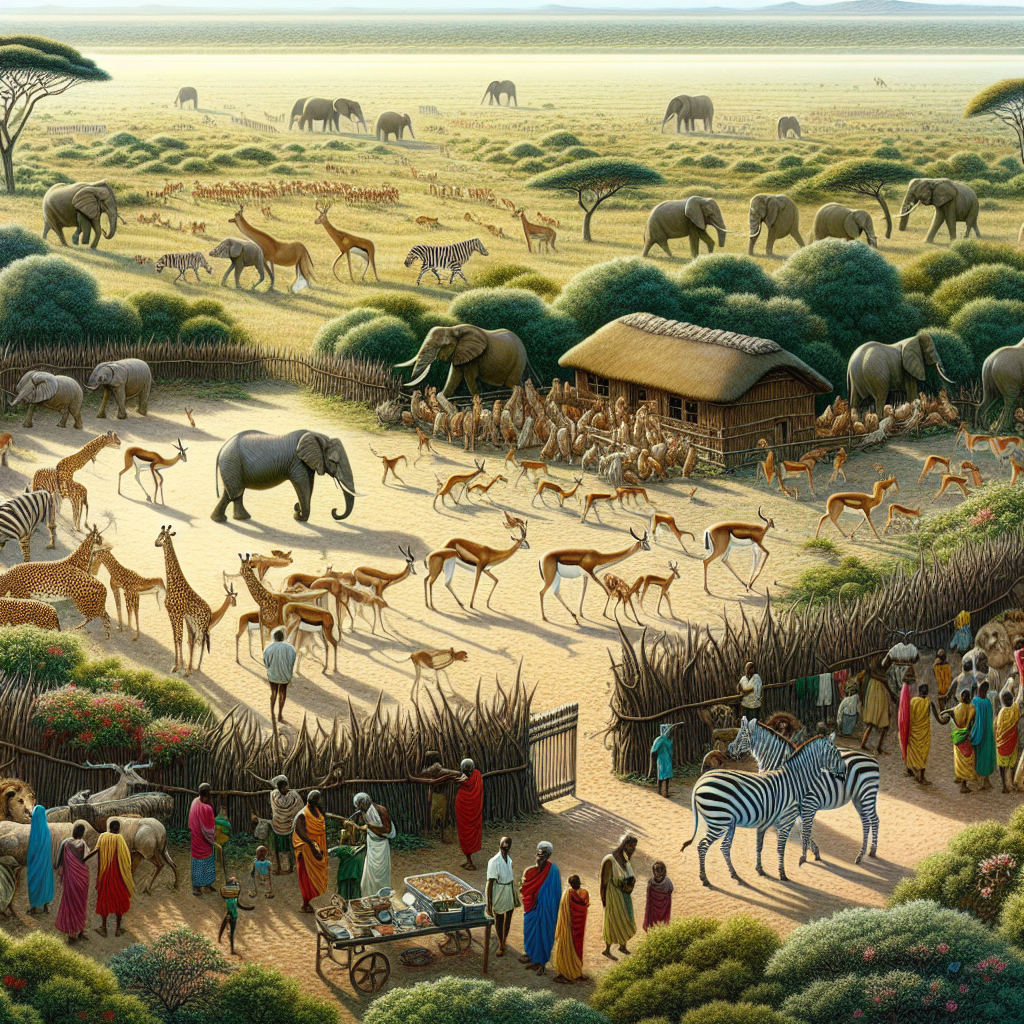So you’re interested in learning how communities can coexist with lions? Well, look no further! In this article, we’ll explore various strategies and success stories of building lion-friendly communities. From implementing livestock protection methods to establishing wildlife corridors, these initiatives aim to reduce conflicts between humans and lions while promoting sustainable conservation practices. With the increasing importance of preserving these majestic creatures, let’s delve into the ways we can create harmonious habitats for both lions and people.
Understanding Lion-Friendly Communities
Definition of Lion-Friendly Communities
Lion-friendly communities are defined as communities that actively engage in the conservation and protection of lion populations and their habitats. These communities recognize the importance of coexisting with lions and work towards creating an environment where both humans and lions can thrive together. By adopting lion-friendly practices and strategies, these communities aim to reduce conflicts between humans and lions, promote sustainable livelihoods, and ensure the long-term survival of lion populations.
Importance of Building Lion-Friendly Communities
Building lion-friendly communities is crucial for the conservation of lions, as well as the overall biodiversity of their habitats. Lions are majestic creatures that play a vital role in maintaining the ecological balance of their ecosystems. They are top predators, and their presence helps regulate herbivore populations, which in turn prevents overgrazing and ensures a healthy ecosystem. Additionally, lions serve as flagship species, drawing attention to the conservation of their habitats and creating opportunities for broader conservation efforts. By building lion-friendly communities, we not only protect lions but also safeguard the entire ecosystem they inhabit.
Strategies for Building Lion-Friendly Communities
Educating and Engaging Local Communities
One of the key strategies for building lion-friendly communities is to educate and engage local communities in the importance of lion conservation. This involves raising awareness about the ecological role of lions, the threats they face, and the benefits of coexistence. Educational initiatives can include workshops, school programs, public campaigns, and community meetings. By involving communities in the conversation and giving them a sense of ownership, they become more likely to support lion conservation efforts and adopt sustainable practices.
Implementing Human-Lion Conflict Management Initiatives
Human-lion conflicts are one of the primary threats to lion populations. As human populations expand and encroach on lion habitats, conflicts arise over resources such as livestock and land. To build lion-friendly communities, it is crucial to implement conflict management initiatives that minimize these conflicts. This can be achieved through the development and implementation of effective livestock protection measures, such as fortified enclosures and guard animals. Additionally, early-warning systems, community-based monitoring, and rapid response teams can help mitigate conflicts and provide timely interventions when needed.
Establishing Protected Areas and Wildlife Corridors
Creating protected areas and wildlife corridors are essential strategies for building lion-friendly communities. Protected areas provide safe havens for lions and other wildlife, ensuring their protection from habitat loss, poaching, and other threats. Wildlife corridors, on the other hand, connect different protected areas, allowing animals to move freely between them. These corridors promote genetic diversity, improve habitat connectivity, and reduce the risk of inbreeding. By establishing protected areas and wildlife corridors, communities contribute to the long-term survival of lions and help maintain healthy ecosystems.

Success Stories: Building Lion-Friendly Communities
Case Study: Lion Guardians Program in Kenya
The Lion Guardians Program is a successful example of building lion-friendly communities in Kenya. This community-based initiative engages local Maasai warriors, who traditionally held negative perceptions of lions, in actively conserving the species. The program recruits these warriors as Lion Guardians, providing them with training and support to monitor lion populations, protect livestock from lion attacks, and promote peaceful coexistence. Through their efforts, the Lion Guardians have played a crucial role in reducing human-lion conflicts, increasing lion population numbers, and fostering a sense of pride and ownership within the local communities.
Case Study: Community-Based Conservation in Namibia
Namibia has also made significant progress in building lion-friendly communities through community-based conservation efforts. Namibian conservancies, which are community-run organizations, have been established to manage and conserve natural resources, including lion habitats. These conservancies engage local communities in decision-making processes, promote sustainable wildlife management, and provide economic benefits through tourism and wildlife-based initiatives. As a result, conflicts with lions have decreased, community perceptions towards lions have improved, and both lion populations and local economies have thrived.
Case Study: Lion Recovery Fund’s Impact in Africa
The Lion Recovery Fund (LRF) is a global initiative that supports the conservation of lions across Africa. Through its strategic investments, the LRF has facilitated the building of lion-friendly communities in various African countries. By partnering with local organizations and governments, the LRF has helped implement effective lion conservation strategies, such as anti-poaching measures, conflict mitigation initiatives, and community engagement programs. The LRF’s support has not only led to an increase in lion populations but has also empowered local communities to become active participants in lion conservation, ensuring long-term success.
Challenges and Solutions
Human-Induced Threats to Lion Populations
Lions face numerous threats caused by human activities, including habitat loss, poaching, and retaliatory killings due to human-lion conflicts. To address these challenges, it is crucial to strengthen law enforcement efforts to combat illegal wildlife trade and poaching activities. Additionally, promoting sustainable land-use practices and supporting alternative livelihood options can help alleviate pressures on lion habitats, reducing the likelihood of human-lion conflicts. By addressing these human-induced threats, we can create a safer environment for both lions and the communities that coexist with them.
Overcoming Cultural and Socioeconomic Barriers
Building lion-friendly communities requires addressing cultural and socioeconomic barriers that may hinder conservation efforts. Local beliefs, traditions, and practices may be in conflict with lion conservation goals, making it challenging to gain community support. To overcome these barriers, it is essential to engage community leaders, religious institutions, and other influential figures to promote the importance of lion conservation within their cultural contexts. Furthermore, providing economic incentives and opportunities, such as eco-tourism and job creation, can help communities see the value of conserving lions and their habitats.
Promoting Sustainable Livelihoods for Local Communities
To build lion-friendly communities, it is crucial to promote sustainable livelihoods for local communities. Poverty and limited economic opportunities often drive communities to engage in activities harmful to lions, such as poaching and habitat destruction. By providing alternative livelihood options, such as sustainable agriculture, eco-tourism, and skills training, communities can diversify their income sources and reduce their dependence on activities detrimental to lion conservation. This not only improves the socioeconomic well-being of communities but also fosters a sense of shared responsibility towards protecting lions and their habitats.

Collaborations and Partnerships
Government Agencies and Conservation Organizations
Collaboration between government agencies and conservation organizations is essential for building lion-friendly communities. Governments play a crucial role in enacting and enforcing policies that protect lions and their habitats. Conservation organizations, on the other hand, bring expertise, resources, and community engagement strategies to the table. By working together, they can develop and implement comprehensive lion conservation plans, facilitate research and monitoring initiatives, and create sustainable frameworks for community involvement. These collaborations ensure a coordinated approach towards building lion-friendly communities.
International Collaboration and Funding
International collaboration and funding are instrumental in supporting lion conservation efforts. In a world where conservation challenges cross borders, international cooperation is essential. By sharing knowledge, experiences, and resources, countries can learn from each other’s successes and challenges, ultimately benefiting lion populations globally. Additionally, securing sufficient funding is crucial for implementing effective conservation strategies, community engagement programs, and capacity-building initiatives. International partnerships and funding mechanisms play a vital role in ensuring the long-term conservation and protection of lions and their habitats.
Local Community Participation and Empowerment
Local community participation and empowerment are vital for the success of building lion-friendly communities. Communities living in close proximity to lion habitats have valuable insights and traditional knowledge that, if incorporated, can greatly contribute to lion conservation efforts. Empowering local communities to take an active role in decision-making processes, implementing conservation initiatives, and benefiting from conservation efforts promotes a sense of ownership and stewardship. By involving communities as partners, their voices are heard, their needs are met, and meaningful and sustainable solutions can be found.
Future Prospects
Integrating Lion Conservation in Urban Planning
As urbanization continues to expand, integrating lion conservation in urban planning becomes crucial. This involves considering the ecological needs of lions and their habitats in development processes, such as creating green spaces, wildlife-friendly infrastructure, and connectivity corridors. By incorporating lion conservation into urban planning, we can ensure that humans and lions can coexist even in urban environments, preventing further fragmentation of their habitats and promoting harmonious interactions between people and wildlife.
Strengthening Research and Data Collection
Strong research and data collection efforts are needed to inform effective lion conservation strategies. By studying lion populations, their behaviors, and their habitats, we can gain valuable insights into their needs and the threats they face. Gathering accurate and up-to-date data is essential for making informed decisions, tracking population trends, assessing the impact of conservation efforts, and adapting strategies as needed. By investing in research and data collection, we can enhance our understanding of lions and develop evidence-based strategies for building lion-friendly communities.
Mobilizing Global Support for Lion Conservation
Mobilizing global support for lion conservation is essential to achieve significant and long-lasting impact. By raising awareness about the importance of lion conservation and the challenges they face, we can garner public support and engage individuals, organizations, and governments worldwide. Public campaigns, educational initiatives, and international forums play a crucial role in mobilizing resources, advocating for policy changes, and fostering a global movement for lion conservation. By uniting efforts globally, we can secure a future where lions thrive and coexist peacefully with human communities.
Conclusion
Building lion-friendly communities is a complex but essential task for the conservation of lions and their habitats. By implementing strategies such as educating communities, managing human-lion conflicts, establishing protected areas, and promoting sustainable livelihoods, we can create an environment where both lions and communities can thrive. Success stories from programs like the Lion Guardians in Kenya and community-based conservation in Namibia highlight the power of community engagement and collaboration. Overcoming challenges related to human-induced threats, cultural barriers, and socioeconomic limitations requires integrated approaches that empower local communities and foster partnerships between governments, conservation organizations, and the international community. By focusing on future prospects like integrating lion conservation in urban planning, strengthening research efforts, and mobilizing global support, we can ensure a sustainable and prosperous future for lions and the communities that live alongside them.

